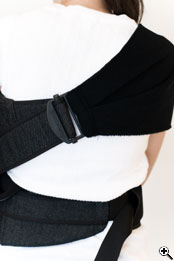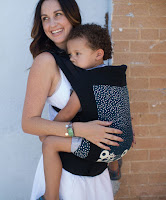All Publicity is NOT good Publicity.
A soundbite style article just popped up on my MSN newsfeed and it made me uncomfortable on so many levels. This has led to a blog post full of 'but'.......... this is a controversial topic in the world of slings that is constantly oversimplified.The headline - "Jamie Oliver's Snap of River Sparks concern from parents over baby carrier safety" is of course designed to get anyone interested in slings, parenting or celebrities to come and have a look - I did. If you want to read it - it's here. It won't take you long.
But these short, articles that are designed for maximum mouse clicks are too short to actually contain anything useful, but instead encourage a spewing forth of judgement and opinion that reinforces stereotypes of different forms of parenting on social media. It is pretty representative of so much of the media coverage of slings, and other aspects of parenting, that it is making it hard for parents to trust their own judgement.
Shouldn't I be pleased, as a sling consultant and business owner, to see the quotes from the NCT, and hipdysplasia.org supporting the use of wider based carriers?
Well, maybe, but it should be as part of a balanced discussion looking at the pros and cons of narrow based carriers, rather than an apparent blanket ban on something that actually many parents and babies find a fantastic tool, and are using successfully and thoughtfully on a regular basis.If you want a really good balanced view, go to one of our experts, like Dr Rosie Knowles. At the risk of sounding a bit in awe (I am) she writes great well researched articles that contain lots of common sense.
So you want to know about hips and slings? Read this.
It is helpful and based on research. Referenced research - which is so often lacking in the sling world online.
What about the controversial front facing out position? Dr Knowles has also has written a s a really useful informed piece that properly acknowledges the different views and the pros and cons of front facing out here
.
These articles do often get shared in sling communities, but we have new parents all the time who are still hearing and seeing these short soundbite articles and being put off asking questions.
Shouldn't I be pleased that slings are in the media and being used by celebrities?
Well, yes of course it is great to see slings being recognised as a great tool by many parents. But reports like these and the negative blunt statements that go with them actually stop many parents from seeking help and assistance with their carriers as they feel they will be judged and told off by those with any expertise.And sadly there are many people out there who are doing that - I hear it all the time.
Parents come into the Slingtastic shop, embarrassed, apologising and feeling guilty because someone they know, someone at a baby group, someone who 'knows a lot about slings' has told them they are using the wrong kind of carrier and causing their child harm. These are the more confident parents that are not scared of being told off , who are able to overcome the often very vulnerable feeling of being judged by their new parenting peers. Even parents who have not been directly spoken to about it have seen the selling and advice pages that ban the trading or selling of narrow based carriers - an indirect criticism that is really confusing when there is a strong market for them in the UK.
How many more parents are not daring to use the carrier they have, are too worried to ask for advice, but can't justify buying another one?
How many parents have a narrow based carrier, and are not 100% sure they are using it right but don't dare go to their local sling shop, library or consultant because they have heard that they will just be told their sling is dangerous - but can't understand why when it is sold in reputable shops and has met EU safety standards?
It is really confusing, and the judgement and criticism makes it hard for people to assess what safety checks they really do need to do, especially with very small babies who sometimes don't fit all buckle carriers in a way that supports them fully and allows their airways to stay clear. These are much, much more important checks to do first and foremost :
Is the baby safe from falling?
Is the baby's back supported enough to ensure an upright position where the chin is far enough away from the chest that the airway is not compromised?
Is there a good airflow around the baby's face to ensure that the baby has enough air to breathe?
Can we just focus on these first please? Then we can look at other safety issues such as temperature, use and specific needs - and discuss the importance of positioning, comfort for baby and comfort for the adult.
And there's another flip side .....
The front facing out position, shown in this article, can ONLY be achieved in a carrier that has a narrow base that is designed for the purpose (and some wraps that can of course be tied to support the position). I am starting to see parents who have done lots of research and bought a carrier with a wider base because they want to support their baby's pelvis and achieve a more natural position for healthy hip development - but have not realised that this cannot then be used safely for front facing out when their baby is older. Yes, yes, I know, surely they have the instructions? If not, can they not go online and look? Great theory but we all know that life catches up with us and we just don't manage to check out everything we mean to, and its always easy when you know how/with hindsight.But are they all going to ask for advice on why it is not feeing quite right? Some do, and either stop carrying in this position, or buy a carrier they can use like this. Some won't, and will really put their child in uncomfortable positions, or be put off using slings altogether - which is a real shame as they are a fabulous parenting tool.
So what do we do when parents with this kind of carrier come in for advice to a workshop, one-to-one or a chat in the shop ?
We do our best to empower the parent. We encourage them to bring the sling/carrier they have to see if we can make it work for them and their child, and help them to understand how best to mimic in-arms carrying and ensure that their baby is safe, and that both adult and child are comfortable. We talk through the pros and cons of different positions. We try our best to undo some of the guilt and worry that has been put upon them. And if they want a carrier that will carry in a front facing out position when their baby is developmentally ready, we show them how to use them!




